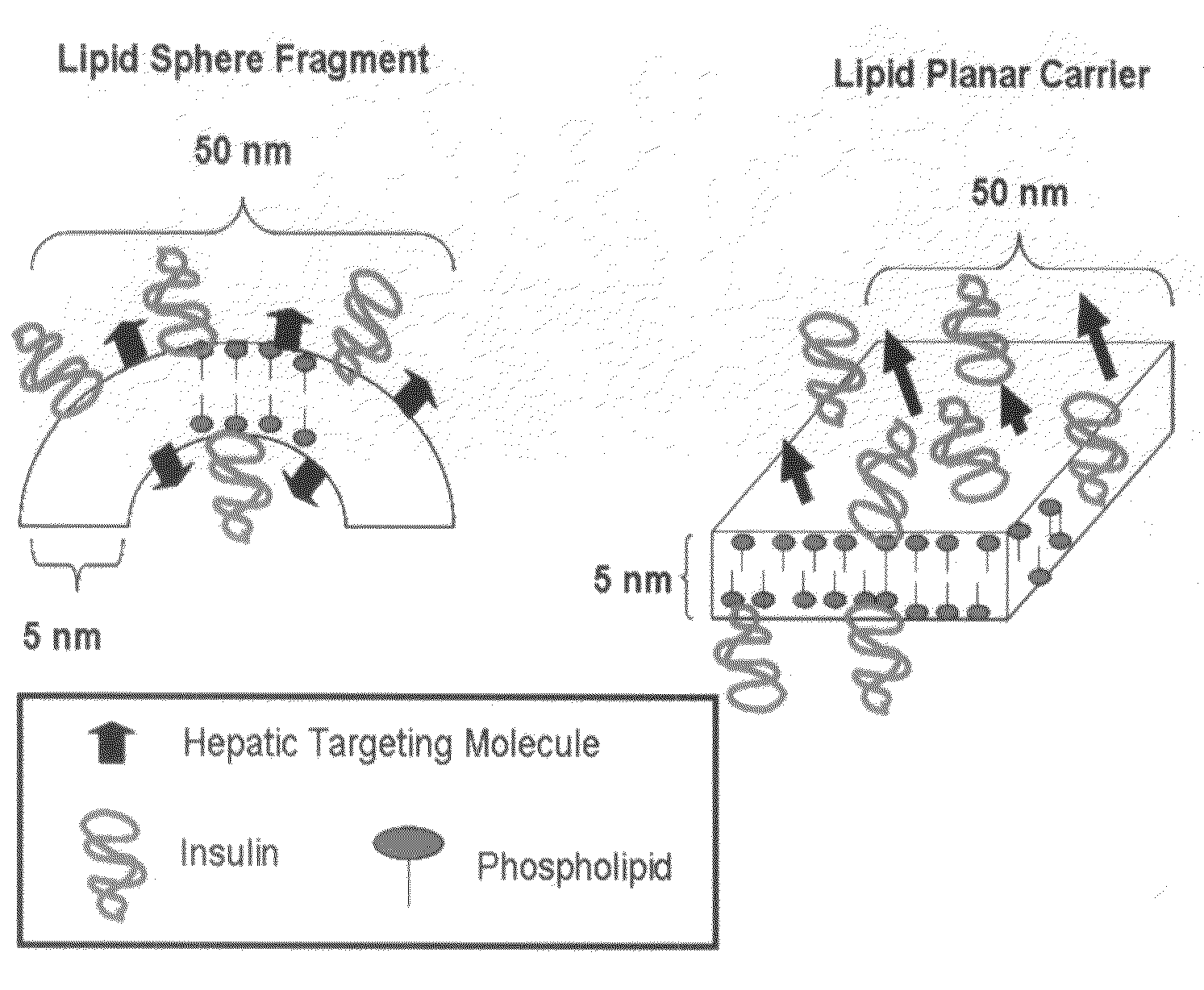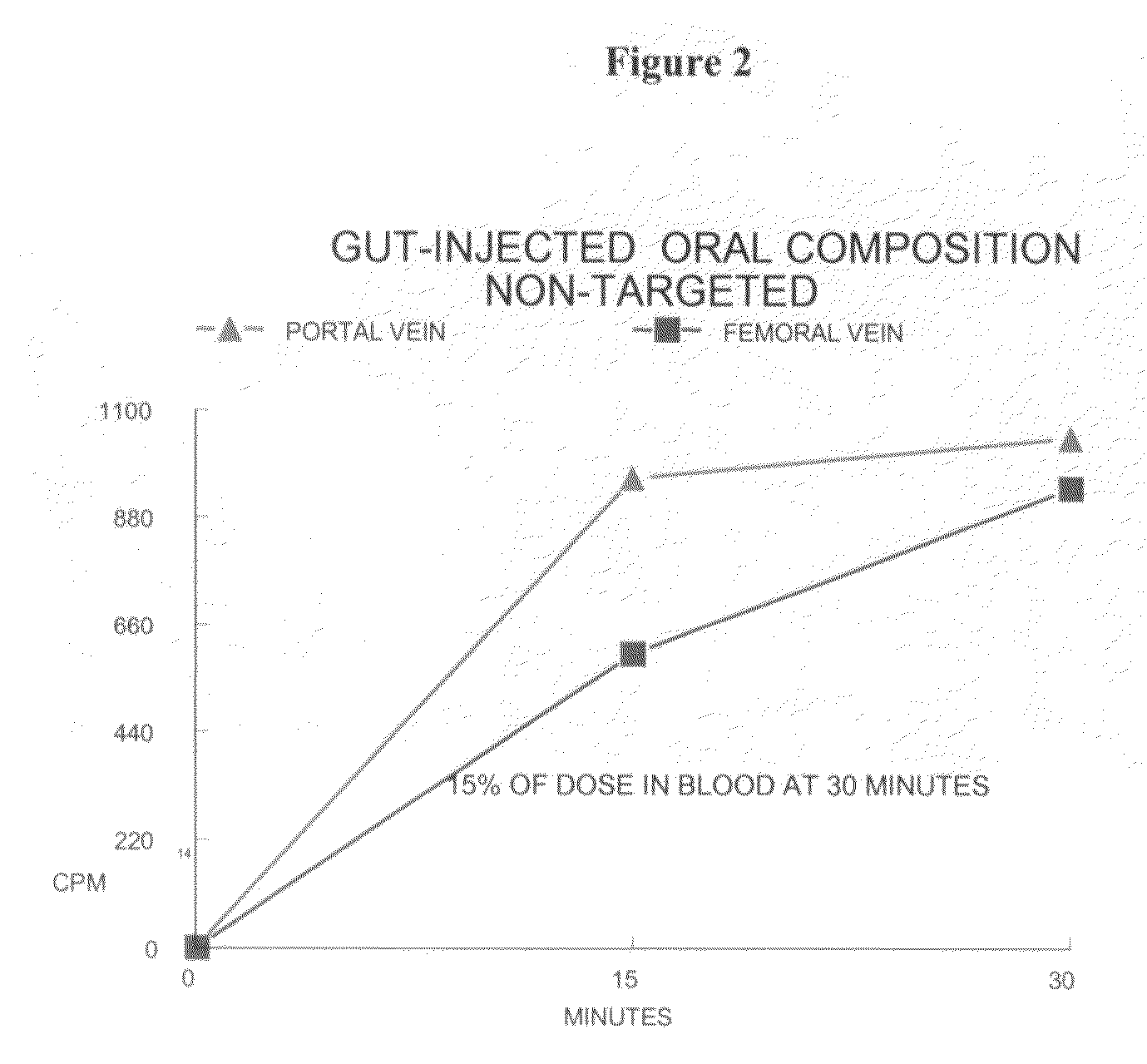Orally bioavailable lipid-based constructs
a lipid-based, orally bioavailable technology, applied in the direction of peptide/protein ingredients, drug compositions, metabolic disorders, etc., can solve the problems of inability to obtain multiple painful injections, inability to obtain oral formulations of many pharmaceutical compounds, and inability to meet the needs of patients, etc., to achieve the effect of reducing the effects of type 2 diabetes
- Summary
- Abstract
- Description
- Claims
- Application Information
AI Technical Summary
Problems solved by technology
Method used
Image
Examples
experimental examples
Experiment 1—Administration of Compositions Not Containing a Targeting Agent
[0182]A composition whose constituent members were created from a mixture of lipid components comprising approximately 62 mole percent 1,2-distearoyl-sn-glycero-3-phosphocholine, approximately 22 mole percent dihexadecyl phosphate, approximately 16 mole percent cholesterol, and no targeting agent was prepared according to the microfluidization procedure generally described herein. A known portion of the lipid component comprised 14C labeled phospholipid. Following filtration through a 0.2 micron filter, the average constituent size was less than 100 nm as measured with a Coulter Sub-micron Particle Size Analyzer.
[0183]A 10 mg / kg body weight sample of the composition (containing 85,000 cpm of 14C radio-label) was then injected into the duodenum of an anesthetized 230 gram fasted, but otherwise normal, rat. Blood was taken from the portal and femoral veins at 15 and 30 minutes post-dosing for counting (FIG. 2)...
experiment 2
argeting
[0185]To demonstrate the absorption of the composition from the gut, a composition comprising insulin and constituents generated from a mixture of lipid components comprising approximately 61 mole percent 1,2 distearoyl-sn-glycero-3-phosphocholine, approximately 22 mole percent dihexadecyl phosphate, approximately 16 mole percent cholesterol, and approximately 1 mole percent poly[Cr-bis(N-2,6-diisopropylphenylcarbamoylmethyl iminodiacetic acid)] (wherein a known portion of the phospholipid component comprised 14C labeled phospholipid) was prepared as recited in the general preparation disclosed herein. Prior to dosing, the labeled composition to rats, the rats were fasted from food for 24 hours and from water for 4 hours. The fasted rats were then permitted to drink water from a graduated water bottle containing the composition. The drinking water bottle was removed from the cage after 15 minutes, the amount of water ingested from the drinking bottle was measured, and the am...
experiment 3
argeting with a Composition In Alloxan-Streptozotocin Treated Mice
[0187]Mice used in the present experiment were made diabetic by administering streptozotocin and alloxan. The diabetic animals were then divided into two groups. The control group (11 mice) was orally dosed with regular insulin. The experimental group (7 mice) was orally dosed with a composition comprising insulin and constituents generated from a mixture of lipid components comprising approximately 61 mole percent 1,2 distearoyl-sn-glycero-3-phosphocholine, approximately 22 mole percent dihexadecyl phosphate, approximately 16 mole percent cholesterol, and approximately 1 mole percent poly[Cr-bis(N-2,6-diisopropylphenylcarbamoylmethyl iminodiacetic acid)] (wherein a known portion of the phospholipid component comprised 14C labeled phospholipid). Dosing was accomplished utilizing the water bottle dosing method described in Experiment 2.
[0188]After being made diabetic, rats in both groups were treated identically over a...
PUM
| Property | Measurement | Unit |
|---|---|---|
| size distribution | aaaaa | aaaaa |
| size | aaaaa | aaaaa |
| diameter | aaaaa | aaaaa |
Abstract
Description
Claims
Application Information
 Login to View More
Login to View More - R&D
- Intellectual Property
- Life Sciences
- Materials
- Tech Scout
- Unparalleled Data Quality
- Higher Quality Content
- 60% Fewer Hallucinations
Browse by: Latest US Patents, China's latest patents, Technical Efficacy Thesaurus, Application Domain, Technology Topic, Popular Technical Reports.
© 2025 PatSnap. All rights reserved.Legal|Privacy policy|Modern Slavery Act Transparency Statement|Sitemap|About US| Contact US: help@patsnap.com



